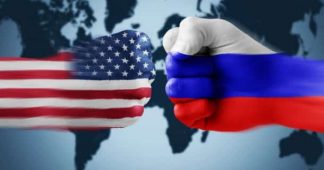By PhD.PROF
Maria Negreponti-Delivanis
02/27/2021
Over the past five decades the West has been going through a period of decline and is gradually entering uncharted waters. And what we know, security and tradition, is clearly retreating, and being replaced by the unknown. Indeed, many signs point to the end of globalization which has proven not to be the system that ensures prosperity for all the inhabitants of the Earth, but the one that has recorded very few winners and countless losers. . I have based myself on two evolutions in order to interpret the decline of the West. I am thinking first of the plausible hypothesis that Western civilization has exhausted the available time that is historically allotted to each civilization, so it is now called upon to pass its sovereignty to its successor. The advanced centers of “Western civilization” already paint a picture of the irrefutable general decline in all manifestations of social, economic, political and cultural life. And it is precisely at this point that the West is focusing on its principles and characteristics to support the fact, as vigorously as possible, that it and it alone represent an ideal and unparalleled mortgage in the world. This is, as everything suggests, the harbinger of the end of the era of Western culture, as happened to all the previous ones who followed the same determined path. This is how they grow, reach their peak and die out. The reason for the decline of civilizations is not linked to a particular regime, or to a particular cosmotheory, or to acts or omissions on the part of the policy followed. On the contrary, the decline of the civilizations of the past was independent of the then regime or of the cosmotheory in force, which had nevertheless been cracked or had adopted extremes during the exercise of their power. Therefore, systems such as capitalism, socialism, neoliberalism or globalization alone do not cause the decline of the cultures in which they operate, but each of them acquires repulsive and dangerous characteristics, while the culture in which they operate. question points to decomposition and disappearance. All culture enters, according to Oswald Spengler, into the terminal phase of its existence, which is winter or, according to Alvin Hansen, into the stage of mature capitalism, which marks its end. The decline and death of civilizations that evolve in cycles of 200-250 years, not only marks the end of an era, but also the dawn of a new one, that is to say the emergence of ‘a new culture that replaces the one that is departing. Western culture was born from the ashes of ancient Greek civilization, with the successive rise, from 1860, of dominant economic centers: Australia, Great Britain and the United States. Currently, the world economy is once again going through a phase that seems trapped in the turn of socio-economic upheavals. In this phase of capitalist evolution, our culture, Western culture, which coexists with democracy, capitalism, liberalism and for 50 years globalization, is threatened with marginalization. There is no doubt that in recent decades Western culture has gradually lost its influence and its appeal and that more and more supporters are abandoning it. The United States, however, as the main representative of Western culture, seems unable or unwilling to admit reality. And secondly I am thinking of the secular stagnation at the unprecedented stage of capitalism, which we are going through and which threatens advanced economies, with the end of growth. So, in the obscure, mysterious and even terrifying realm of crop rotation, this second threat to the future of the world’s advanced economies has been analyzed by the famous American economist Alvin Hansen. This is the theory of secular economic stagnation. According to this theory, the arrival of the secular stagnation phase must be seen as an inevitable consequence of the system of mature capitalism which, once reached a certain critical point, is no longer capable of fueling growth. Alvin Hansen defines this evolutionary phase of capitalism as follows: “the weak and ephemeral resumptions of activity which barely die, depressions which are self-sustaining and lead to persistent unemployment”. This theory had been forgotten for some 80 years and recently revived by Lawrence Summers and his team. While crop rotation affects the whole of social, economic, cultural and perhaps even religious life, the secular stage of stagnation essentially affects the economy.
Yet the character of these two cases is determined. This means that any attempt to subdue them would only delay their arrival, without it being possible to prevent them. A parenthesis, however here to appeal to the contribution of globalization which precipitated the decomposition of the West through:
* The abysmal inequalities in the distribution of income and wealth, which is the most harmful fact of globalization
* And until recently, inequality in the distribution of income and wealth was seen as an unavoidable phenomenon, as an exclusively social and not an economic problem
* But the IMF recently showed that when the richest 20% of the population increase their income by 1%, growth slows by 0.08% in the following five years, and conversely, a 1% increase in the income of the Poorest 20% of the population accelerates growth by 0.38% in the next five years
* Certainly one of the reasons which accelerated the decline of the West is the weakening of the role of national governments having delegated a large part of their sovereignty to the “invisible hand”, supposed to regulate the markets, but also:
-The deliberate abandonment of the full employment policy
-The abolition of respect for national borders
– The migratory wave to Europe
– The virtual economy has been encouraged to the detriment of the real
– Terrorism
-The implementation of the Coudenhove-Kalergi plan: The genocide of the peoples of Europe
And many others.
I return to the decadence of constant stagnation, such as moral decay, decadence of the core values of life, education, the administration of justice, the welfare state, explosion of king’s money , crime, and of course, the diminishing importance of democratic principles.
Moreover, in both cases, that of crop rotation, like that of the arrival of the secular stage of stagnation, one foresees the existence of successors and not a vacuum. Precisely the essential anomaly of modern advanced economies, which refers to the theory of eternal stagnation, exhibits the following characteristics, which persist despite some signs of growth:
First, the interest rate remains very low, or below zero, describing a frozen situation, where the demand for savings is greater than the demand for investment.
Second, banks, in order to re-introduce the balance between saving and investment, should reduce the level of the interest rate.
However, this is not possible, since this level is already very low and it is more a question of raising it.
Third, if the supposed upswing of the business cycle begins with such a low interest rate, that rate could not drop even lower to reinvigorate economic activity, in case it threatens to be delayed.
This then means that advanced economies no longer have this very effective weapon of interest rate manipulation to resolve imbalances in the economy.
Fourth, despite the revival of the world economy and the colossal wealth accumulated in the hands of a few, productive investment has not been encouraged, especially public investment.
Fifth, the global public and private debt is constantly increasing, despite the introduction of austerity policy on the planet, and especially in Europe in recent decades.
Sixth, inflation, wanted around 2%, nevertheless remains below and often in deflation
And seventh finally, despite the recovery, during certain periods wages are still frozen at low levels.
Add to these concerns the fear caused by the exorbitant global debt, public and private.
This continues to climb, reaching 164 trillion dollars or 225% of the annual world GDP in 2019.
It is now out of control because of the pandemic, which has spent an estimated 26 trillion dollars in “money per helicopter”
Part I. The West is plagued by insurmountable problems
A. The problems of the West
These are the problems that arose especially after the great economic crisis of 2008 and are likely to be final for the world economy. They boil down to the increasingly frequent and lengthy ineffectiveness of macroeconomic policy which fails to achieve general equilibrium, namely economic and monetary.
The causes of this new and extremely difficult situation are numerous and persistent, such as:
a) The impossibility of reaching general equilibrium because of an overabundance of savings which is not absorbed by investment and because of a supply of products and services in the face of insufficient demand , which end up lowering the general price level.
Lawrence Summers, in bringing out Alvin Hansen’s theory of the end of growth, explains why falling real rates, coupled with low inflation, may never achieve full employment.
b) The few signs of the eternal stagnation of the West are:
* The low rate of growth
Until 2017, almost ten years after the onset of the crisis, the US economy is growing by around 2%, while the EU is growing at an even slower pace than America. These rates are disappointing for those who plan and for consumers, as they fall short of expectations, and fuel their fears that the recession will last for a long time to come.
* The collapse of investment
Since the start of the 2008 financial crisis there has been a sharp drop in investment in Europe.
* Negative interest rates
This is a far from orthodox measure, which was first adopted by the EU.
This measure exudes anguish and is indisputable proof that all available and traditional monetary policy measures have been unable to revive the European economy and to a Western extent. It is the largest economic experiment in world history, the effects of which are as yet unknown.
* The new content of the technological innovations of capitalism seems unable to lead to an increase, at least visible, in productivity because of its qualitative rather than quantitative result
* Long-term unemployment
The unemployment rate remains high in Europe, and very high in several southern European economies. Regarding the unemployment rate in the United States, despite a less deflationary monetary policy, it has fallen alongside GDP, strengthening the idea that this is the beginning of a new stage in of the evolution where growth is absent, as it emerges from a study on the subject, the number of men from 24 to 54 years old has not stopped decreasing in employment for 40 years, as well as the creation of new jobs.
* Traditional tools no longer work
It turns out that in the West we need new interpretive tools that are not yet available. As a result of this shortcoming, the functioning of modern economies has become chaotic, subject to the law of the jungle. It appears that drastic changes have taken place in the macroeconomic environment, and that they no longer allow the hypothesis of ” stable and sustainable income and employment Europe and America have been sending out economic signals since 2009 that are unresponsive to internal and external stimuli
This means that traditional monetary policy will henceforth be unable to simultaneously achieve conditions of full employment, rapid growth and financial stability.
B. The reasons for the decline of the West
α) Demographic evolution
One of the most important interpretations of Alvin Hansen’s secular stagnation theory is the slowing of the rate of population growth. This development can be observed in many modern advanced economies, and more in Europe, which has shown a negative pace since 2010. The harmful consequences of the aging of the European population are multiple, and reduce:
• real GDP in relation to potential,
• demand for new housing,
• the propensity to invest and innovate,
More precisely, the world population is expected to increase from the current 7.3 billion to 8 billion in 2030, to 9 billion in 2050 and to 11.2 billion in 2100. This increase of the order of 50% of the world population in 2100 will be Unevenly distributed Europe and East Asia are estimated to see their populations decline, but the population will increase dramatically in developing economies to around 4 billion, potentially slowing their growth. The percentage of the population of the United States and the EU in 2025 will not exceed 9% of the world population, while the population in Asia is already 50%. The problem of an aging population and the collapsing of the middle class are interpreted as an autonomous evolution of mature capitalism.Research that has concerned OECD economies concludes that their aging populations will have negative consequences growth. Precisely when the share of the population over 60 increases by 10%, growth drops by 5.5% per capita. The elderly European population will almost double, in 2060. And while today in the European Union, there are 4 people of working age for 1 retiree over 65, in 2060 there will only be 2 people for each retiree.
While in the West, the middle class, the engine of progress of any economy, is weakened, its specific weight at the global level is increasing considerably, especially in Asia. It should also be added the fact that the regions that will ensure global growth are no longer the same and, what is particularly significant, that they are moving away from the West, which reinforces the estimates according to which the latter will be overtaken by secular stagnation. Finally, it should be added that beyond these difficulties known to the West, a catalyst danger is looming on the horizon which concerns the global hegemony of the dollar. Russia and the BRICS are moving towards an alternative international monetary system, aimed at ending the long domination of the dollar as an international reserve currency.
Summarizing Part Ι as follows: The chronic declining participation of the West and the very rapid growth of emerging economies is relentless and does not allow to hope for a possible reversal of the trend. In 1955, for example, the G-7’s share of world GDP was 45%. In 2018, it had fallen to 31% and according to estimates, it should only be 20% in 2050. The share of emerging economies in world GDP follows the opposite trend, namely that in 1995 it was 22 %, in 2015 it was 36.3% and is expected to reach 50% in 2050. In other words, a complete overthrow of the existing international economic order, with China in the leading role.
Part II. The East embodies the new international economic order
The weakness of the West goes hand in hand with the very rapid rise of the new superpower the East led by China The arrival of a new world carrying a new international economic order seems almost determined Indeed, developments, analyzes and statistics, everything shows that soon the West will be forced to cede its throne to China. It is also expected that this new dominant world power will gradually take over from other emerging economies in Asia and Africa. A bitter irony hangs over the world, owing to the fact that it was America that made the choice of globalization, when in the early 1970s, it had concluded that in this way it would eliminate the risk of being taken over. by Europe or Japan. At that time America did not foresee that the great hidden danger was China, this poor and marginalized giant. And while globalization has brought misfortune to the West, it has on the other hand ensured the rise of China and other emerging countries. Now that China poses an undeniable threat, America’s only reaction, at least for the moment, is to turn back the clock, once again opting for protectionism. It is certainly difficult to predict international developments, but it seems unlikely, if not impossible, that America can prevent the primacy of China:
* First, because in many ways the size of China’s economy is already larger than that of the United States, and nothing seems to prevent it from continuing there. Add to this point that the pandemic has, ultimately, favored China, since it is the only economy in the world with a positive rate of growth.
* Second, because the globalization with specific standards that China is eagerly preparing and which should be completely different from the declining Western globalization, threatens to destroy everything in its path. Indeed, Chinese globalization is based on rigorous and precise planning which has previously determined which products and in what quantity China will place on the international market.
* And third, because China has already passed into the phase of strengthening domestic consumption, imposing a restriction of its dependence on exports, and the great “Silk Road” project is progressing successfully. This is how the rise of China was spectacular since from 1971 to 2013 was able to increase its GDP by 34 times. This miracle has no precedent in world economic history. This miracle was made possible by the fact that since 1979 and until 2016, China achieved an average growth rate of its economy of 10% per year. America continues to have a per capita income 4 times higher than that of China, but the difference is steadily decreasing and barring the unforeseen before 2025 China will surpass the GDP of the United States. China’s GDP in PPP terms has most likely exceeded America’s. China’s share in international trade has exceeded that of the United States. China is already the largest economy in the world in terms of industry, export and import goods, but also in terms of the volume of foreign exchange in its possession. It is now the second largest trading partner of the United States. , the third largest market for their exports and the first for their imports. In recent years the trade war which was in effect a war on new technologies has reduced trade between the two superpowers. commercial with Europe while finding open doors
A. Factors That Contributed to China’s Dramatic Rise
Emphasize above all the fact that China has succeeded to perfection in combinations that seemed generally impossible, such as:
-make a free and competitive market coexist with a large public sector
-a planned economy, with a private sector,
– the private sector in China indeed has a privileged place, on condition, however, that it remains under the control of the government.
-capitalism with communism
– an authoritarian regime with a liberal democracy.
Despite the bad forecasts and its huge population, China was able to overcome the “middle income trap”. This is the difficulty faced by many emerging economies, especially Latin America and Asia, in exceeding the average per capita income of around $ 5,000 per year. This is because from the start the decision-makers were aware of the dangers and constantly changed the plan. Thus, from 1978 to today, China lifted 700 million people out of poverty who founded the middle class. More specifically, it is estimated that by 2025, 2/3 of the population will belong to the middle class. In the new technology sector, China has also denied the West’s beliefs that only “free and open societies are capable of innovating”, as its extraordinary and rapid successes have been achieved under the watchful eye. close and with the help of the Party. This is precisely the area of technology in which China has jumped phenomenally, having started very low and having probably already overtaken the United States. The trade war between the two superpowers, as well as the accusations of theft and espionage of America is explained thus the area of conflict is the new technology. The goal, therefore, that will be at the center of the trade war between America and China is for China not to beat America in the field of technology, but research and development spending in China. increased from 0.7% of its GDP in 1991 to 1.8% in 2010, planning that in 2022 it should overtake the US The development of new technologies have contributed enormously to growth, to the advancement of industry, pollution control, and inequality reduction China’s total expenditure on R&D reached $ 279 billion in 2017, and thus shows an increase of 70.9% compared to 2012. China has still had an unsurpassed and unique advantage, due to the size of its economy, which made it very important the economies of scale single factor for robots. China, throughout its period of accelerated growth, was courageous, unafraid of the budget deficit and, therefore, inevitable inflation. On the contrary, it largely met the needs for economic liquidity. Note also that the household savings rate has reached 50% of their income, in order to finance a massive investment. Indeed, China covers 30% of global investment, but only 10% of consumption – now the situation is improving with increased consumption. Education in China has received a massive reform, which has yielded impressive results in that when skilled Chinese emigrate abroad they prove to be extremely talented and competitive too, a competition organized by the OECD for students from Shanghai, have a level significantly higher than the average for OECD countries.
B. China’s political regime
China has gone from communism to a form of mixed system made up of elements that form an original capitalism that could be called “Chinese capitalism”. This Chinese capitalism is made up of strong elements of “state capitalism”, it is inherent in the Communist Party combined with much of the ideas of JM Keynes. This regime is different from that in the West, yet very effective and it is the People’s Republic of China. China’s big problem, according to the West, is the lack of democracy. China responds, “Everyone wants the benefits of democracy, but political agents would make a fatal mistake if they thought they would get there just by transplanting the entire Western political system.” Indeed, the West was certain that democracy by Western standards is the only system capable of guaranteeing the well-being of the people. America is convinced of the universality and immortality of democratic values and human rights and seemed convinced that China would join this regime as soon as it had fulfilled the preconditions since the West could not accept. the fact that an authoritarian regime could be just as effective as Western democracy and in addition the West could not accept the fact that a “democracy” could exist outside the West, with completely different standards and preconditions but whose goal is the same, namely the prosperity of its people. China, for its part, believes that what matters to a government is not how it was chosen, but its aptitudes, its skills, its effectiveness. China’s performance, and not only, suggests that the West does not have a monopoly on the advantages of democracy, but that these advantages can be acquired by processes different from those of the West’s “popular support” and it is about its link with democracy: as it is already affirmed in the Selected Works of Mao: “To establish a link with the masses, we must conform to their needs, to their desires”.
C. Chinese globalization
Now that traditional Western-style globalization is on the wane, China’s rise comes with a new globalization very different from that of the West. It is about Chinese globalization, which had been presented by Xi Jinping in 2013 as “One belt, one road”, and which has the ambition to “shape the world” around a new international economic order whose core will be China. This is Xi Jinping’s great project, which he himself qualifies as the “new Marshall Plan”, but in a more daring version than the previous one. The “Silk Road” was, 2000 years ago, the main commercial axis. It was by this route that Genghis Khan arrived in Europe, and it was by this route that Alexander the Great almost reached China. The fusion of these two great civilizations, Greek and Far Eastern, gave an extraordinary impulse to the sciences, the arts and the philosophy. The penetration of Alexander the Great in the Far East, by the Silk Road, allowed the foundation of new towns, many of which bear his name, and spread Greek culture and Greek thought to the most distant regions. . Economic growth had made the cost of moving goods through the “Silk Road”, which had been abandoned for centuries, prohibitive. But again, new technologies have brought back the economic opportunity to operate this route, as rail traffic has become fast and affordable.The information about the frantic preparations for this new and original globalization, planned and carried out by China, although reported discreetly and without fuss, certainly deals with the most important event, given that in the long run, it will change the face of the world. It is about a globalization with a completely different philosophy, which makes a clean sweep of all its previous forms. With a budget of trillions of dollars, China intends to revive the “Silk Road”, implementing colossal infrastructure works in Laos, Pakistan, Kenya, Europe. China plans to lay out railway lines that will start in Budapest, Serbia and thus provide an additional artery to distribute its products in Europe. The port of Piraeus, bought by China, will be its springboard to Europe. The “One Belt, One Road” project, promoted by Chinese President Xi Jinping, provides for the construction of infrastructure in Asia, Africa and Europe, and will improve the quality of life of people in more than 60 countries around the world. The objective of this major works project is to enhance, as much as possible, the strategic advantage available to each participating country.
Specifically, Chinese engineers are building hundreds of tunnels and bridges in the jungle of Laos that will support the rails of the 414 kilometer long railway line. This project plans to connect six Asian countries and the estimated cost is $ 6 billion. China is also building power stations in Pakistan to provide electricity to regions that lack electricity. These investments are estimated to amount to $ 46 billion. In Kenya, China is improving the rail line that connects the port of Mombasa to Nairobi, to facilitate access to its products. This railway line was commissioned in the summer of 2017, and its maintenance will depend for several years on China. Major infrastructure projects are planned or have started in Vietnam, Bangladesh, Sri Lanka, Cambodia, Tanzania, etc. Funded by China, the construction of a railway line is scheduled, from Budapest to Belgrade, to provide a new artery to distribute Chinese products in Europe, via the port of Piraeus. By mutual agreement and with others, colossal investments in infrastructure projects, in progress or to come, on the three continents, Asia, Africa and Europe, China is in the process of building its empire global, its own globalization. It is intensifying its influence and strengthening its presence also in the South Pacific. During the period 2006-2016, it offered its assistance in the region to the tune of 1.78 billion dollars for infrastructure projects. The people of the region are willing to follow her, as the aid and the attractive loans she gives them are not subject to the strict conditions of the West. This is why the West began to worry about its expansionist and limitless aspirations. But it is above all Australia that is worried to know, even if this news has been denied on both sides, that Beijing has reached an agreement with the government of Vanuatu which provides for a permanent Chinese military presence on its archipelago. France is also worried about the intensification of China’s influence in Australia, which explains the brief trip Emmanuel Macron made there in May 2018. the “New Silk Road” reach $ 1.7 trillion per year. Along with the maritime and land silk route, Xi Jinping is planning a “polar silk route”. Because, even if the Arctic is not very close to China, it aims to integrate it into its great project of the “new silk road”. So he plans to build ports and the infrastructure necessary for mooring ships, especially now that the sea ice is melting. China, as a “polar power” will continue with the construction of a railroad opposite Finland. The astronomical sums necessary for the realization of this gigantic project justify the fear of serious threats. The communist regime in Laos is seen as a real threat, as is general political instability in the region and corruption. However, the Chinese president seems certain that in the long term, the benefits for his country will far exceed the sums invested, however large they are. It is expected that the completion of this project will employ 100,000 Chinese. America’s concern about China’s surge on the entire planet is shared by the European Union, which, with good reason, also feels threatened. This is because China has already moved closer to eleven EU Member States and five Balkan countries with which it cooperates and finances. These countries are: Hungary, Bulgaria, Romania, Poland, Bosnia and Herzegovina, Serbia, Croatia, Slovenia, Albania, FYROM, Montenegro, Czechia, Lithuania, Latvia and Estonia. America and Europe fear the expansion of China in the Balkans and especially of its ally, Russia, hence their desire to find an agreement as soon as possible on the name of FYROM so that this small State can integrate NATO and the EU and protect itself from a possible negative impact. However, China has already bought Tirana International Airport, the largest steel mine in Serbia, a large coal mine in Romania and the port of Piraeus in Greece. Reacting to this, EU countries and allied sources argue that China “seeks to infiltrate the EU and shatter its cohesion.”
Part ΙΙΙ. Could Thucydides’s trap be inevitable between West and East?
This is an acute and complicated problem that cannot have a clear answer, at least for the time being. Indeed, there are pros and cons, and we can go through them quickly. In order to get a first idea of what may happen in the future, let’s first look at the famous Thucydides dilemma (or trap) which explains the causes of the Peloponnesian War. The interpretation of this dilemma is considered more current than ever, as it attempts to shed light on the nature of the relationship between the United States and China. Thucidides is currently extensively studied in the White House, under the direction of Harvard Professor Graham Allison who wonders if America and China can escape Thucydides’ trap the trap is fear – the fear of losing primacy. Faced with the rise of an emerging power the fear that Sparta had of the growing power of Athens and which provoked the Peloponnesian War, America’s fear of the rise of China can lead to a war and disaster. Thucydides’ study is still relevant in the United States. Times change but the great problems that men have to face remain the same, such as the question of war. The work of Thucydides remains essential because it analyzes in depth the real causes of the conflict between Athens and Sparta, 2000 years ago. And as Thucydides writes “History is an eternal recommencement”. Let us return, then, to the original question: Is a war between the United States and China really possible?
a) Which ones can be taken as worrying signs?
First of all, it is worrying the fact that suddenly, when China is one step from the top of the world, and nothing more seems to be able to prevent its world economic domination, the West becomes aware of the threat. Chinese, accuses China of being its economic enemy and unites to face the eastern invasion. It is obvious that a conflict between the two superpowers, America and China will be due to the threat that America will lose its global economic hegemony. Indeed, until the Congress of the Communist Party, China regarded the West with tolerance and humility, reassuring it that it was not demanding anything. But this situation has changed radically after the Congress of the Chinese Communist Party and the renewal of the presidential mandate of Xi Jinping. So China announced its intention to become the world’s largest economy and demote the United States to second place.
The problem is, after so many decades America is unwilling to give up its place. More exactly, as everything shows, America rejects this possibility, even if China climbs four to four the steps of world power. So at this point each of the two great powers considers itself worthy of being in first place, and then each of the two superpowers shows a superiority complex. And to this superiority complex and arrogance is added the question of the superiority of culture. According to the words of the Chinese president or his officers, “no civilization is comparable to that of China”. The leaders of the Communist Party reject Western liberalism which, while guaranteeing freedom, has weakened the West. However, unlike America, which considers that all the peoples of the Earth must adhere to democracy and liberalism, China does not seek to impose its own worldview choices on the rest of the world. of the greatest value of their model towards which the world will end up orienting itself of its own free will. Although China is not yet ready to confront the EE militarily, it is nevertheless systematically preparing itself for a possible use of armed force. Yet China can already be considered a significant naval power with a number of state-of-the-art warships rivaling those of the United States. But if we turn away from the field of traditional warfare to look at its successor, that is, autonomous robotics, then it is China that predominates autonomous robotics, in the event of war, we can imagine terrifying situations which cannot be ignored. It is not at all certain that efforts to avoid them are successful. And alongside these differences in civilization and regime, the trade war, mainly based on new technologies, continues fiercely, possibly preparing a traditional war between the two superpowers.
b) On the other hand there are tranquilizing signs. So :
One could possibly conclude that, for the moment, neither of the two superpowers wants to get involved in an armed conflict of a traditional form, first of all because the priority of China is the development of a strong middle class, improving the standard of living of its inhabitants and disseminating, using and exploiting new technologies. And on the part of the United States its attitude towards China is clearly more moderate than towards Russia although, for the States – United and the West in general, the danger whatever it is, in fact comes less from Russia than from China, it is Russia which is in the crosshairs, which in itself is strange and incomprehensible and suggests that, mysteriously as it sounds, the Cold War did not end in 1989 and is still going on. This is how it can be said that China inspires greater confidence in the West than Russia. And this, perhaps because Russia is militarily superior to China. So China’s reluctance towards armed conflict can also be explained by the fact that, according to estimates, it will not be able to confront America militarily before 2050.
In conclusion, one could notice that if the “Thucydides trap” is not considered peacefully until then, the development of things in the West risks taking a tragic turn. This is because ten years from now, the idea of war and how to prepare for it will have nothing to do with today’s. In ten years, the robots, which will then most likely be autonomous, will take charge of wars and bring them to a successful conclusion. Wars very different from what we know, more destructive, but also much shorter. And within a few years, as we can already see, China will undoubtedly be ahead of American robotics.
* Extract from the book by Maria Negreponti-Delivanis, “The end of the economic domination of the West and the invasion of the East”, Editions L’Harmattan, 2020 (Canada rating: 4 stars)
**Former rector and professor in economics











